1997 CHEVROLET CAMARO check oil
[x] Cancel search: check oilPage 137 of 404
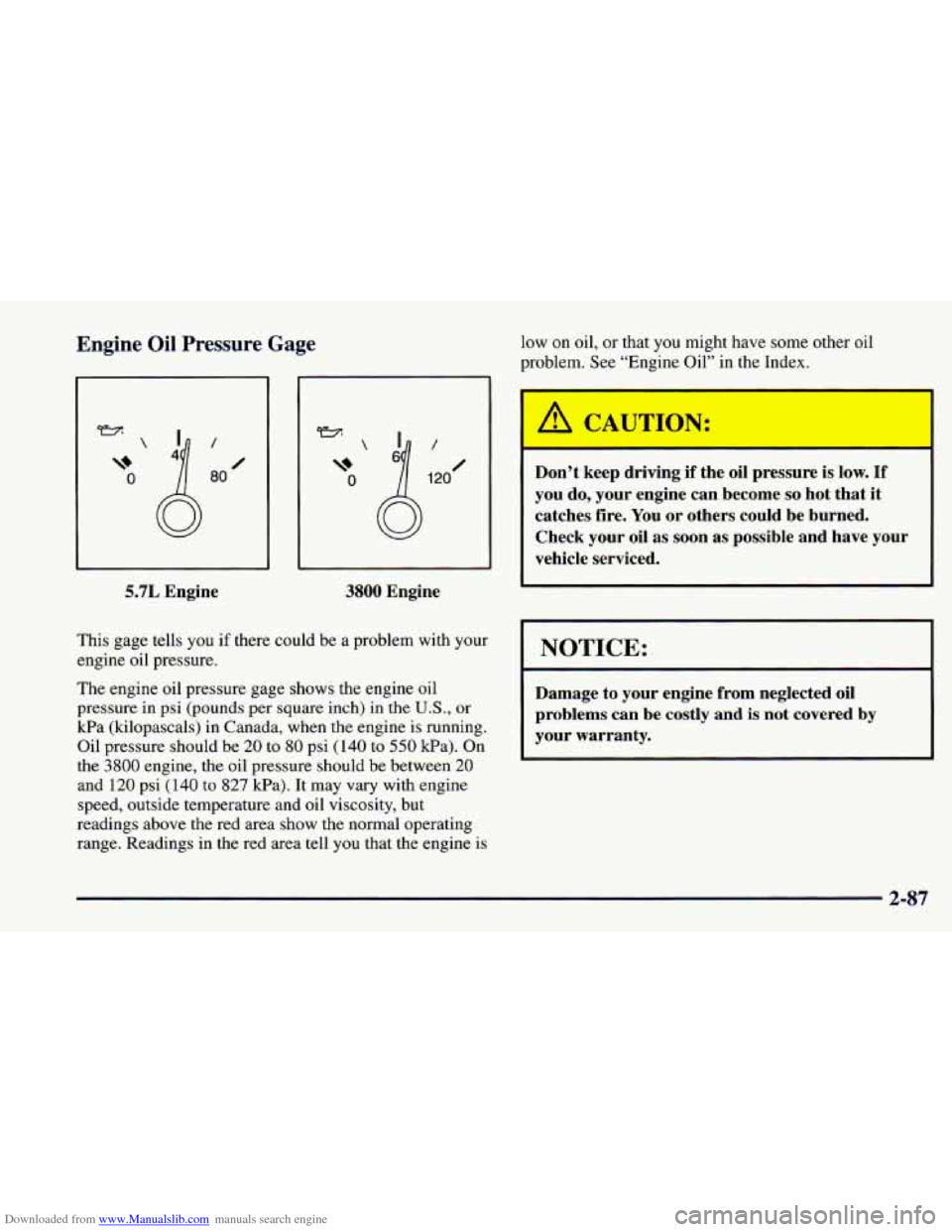
Downloaded from www.Manualslib.com manuals search engine Engine Oil Pressure Gage low on oil, or that you might have some other oil
problem. See “Engine Oil” in the Index.
\+
0
/
0 80
ez
\+
0
/
120 0
5.7L Engine 3800 Engine
This gage tells you if there could be a problem with your
engine oil pressure.
The engine oil pressure gage shows the engine oil
pressure
in psi (pounds per square inch) in the U.S., or
kPa (kilopascals) in Canada, when the engine is running.
Oil pressure should be
20 to 80 psi (140 to 550 kPa). On
the
3800 engine, the oil pressure should be between 20
and 120 psi (140 to 827 kPa). It may vary with engine
speed, outside temperature and oil viscosity, but
readings above the red area show the normal operating
range. Readings in the red area
tell you that the engine is
Don’t keep driving if the oil pressure is low. If
you do, your engine can become so hot that it
catches fire. You or others could be burned.
Check your oil as soon
as possible and have your
vehicle serviced.
I NOTICE: I
Damage to your engine from neglected oil
problems can be costly and
is not covered by
your warranty.
Page 138 of 404
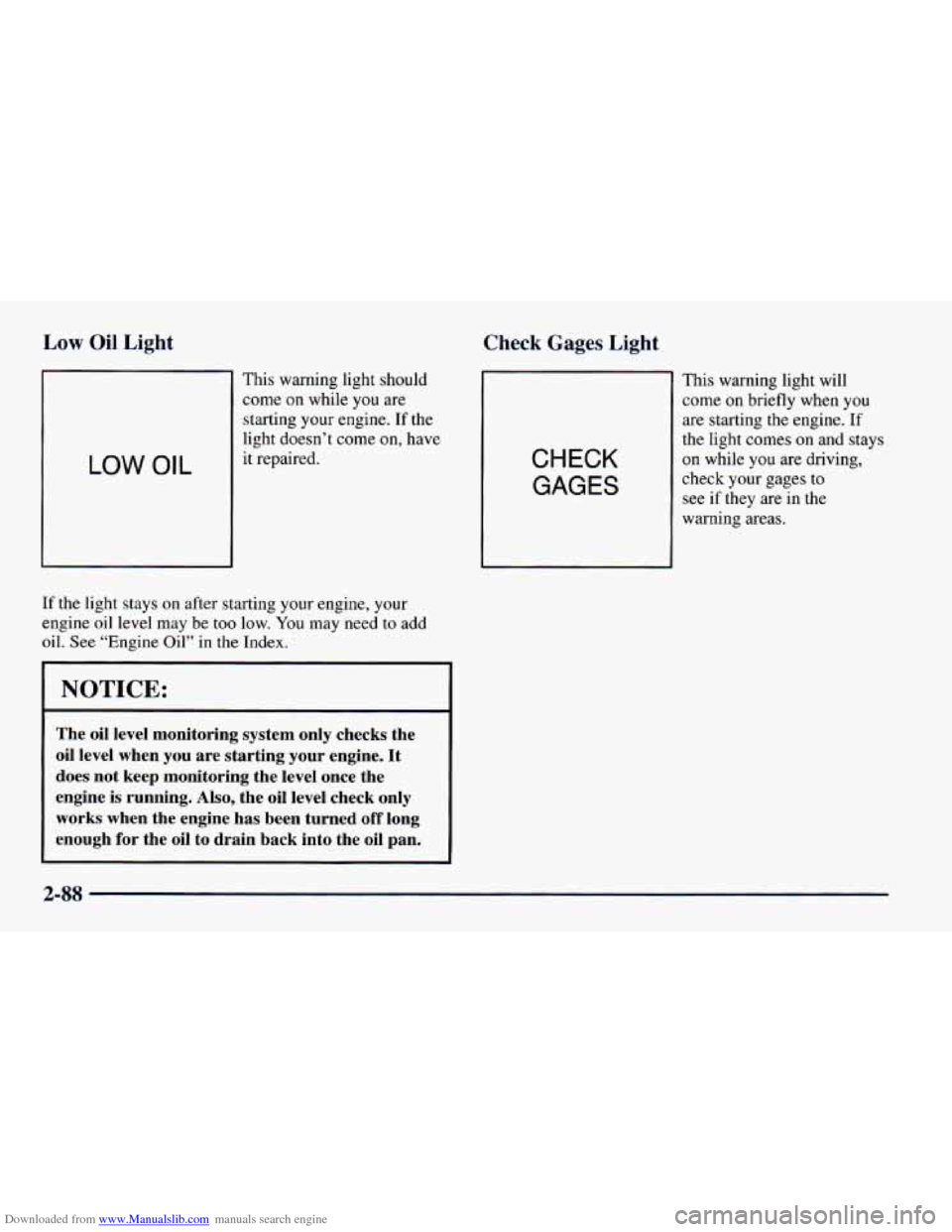
Downloaded from www.Manualslib.com manuals search engine Low Oil Light
This warning light should
come on while
you are
starting your engine.
If the
light doesn’t come on, have
LOW OIL it repaired.
If the light stays on after starting your engine, your
engine oil level may be
too low. You may need to add
oil. See “Engine Oil” in the Index.
NOTICE:
The oil level monitoring system only checks the
oil level when you are starting your engine.
It
does not keep monitoring the level once the
engine is running. Also, the oil level check only
works when the engine has been turned
off long
enough for the oil to drain back into the oil pan.
Check Gages Light
CHECK
GAGES
This warning light will
come
on briefly when you
are starting the engine. If
the light comes on and stays
on while
you are driving,
check your gages to
see if they are
in the
warning areas.
2-88
Page 164 of 404
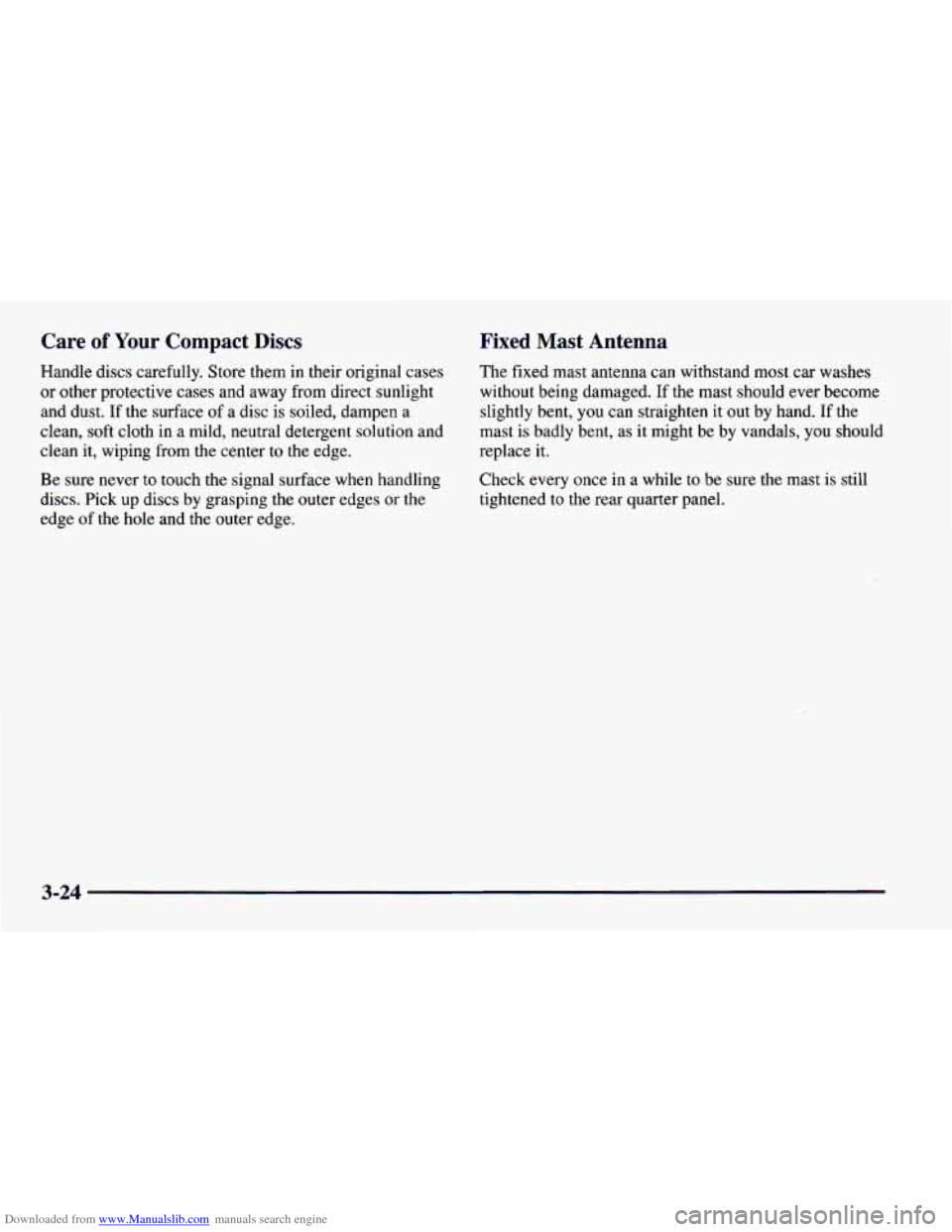
Downloaded from www.Manualslib.com manuals search engine Care of Your Compact Discs
Handle discs carefully. Store them in their original cases
or other protective cases and away from direct sunlight
and dust. If the surface of a disc is soiled, dampen a
clean,
soft cloth in a mild, neutral detergent solution and
clean it, wiping from the center
to the edge.
Be sure never
to touch the signal surface when handling
discs. Pick
up discs by grasping the outer edges or the
edge
of the hole and the outer edge.
Fixed Mast Antenna
The fixed mast antenna can withstand most car washes
without being damaged.
If the mast should ever become
slightly bent,
you can straighten it out by hand. If the
mast is badly bent, as it might be by vandals, you should
replace it.
Check every once in a while to be sure the mast is still
tightened to the rear quarter panel.
3-24
Page 187 of 404

Downloaded from www.Manualslib.com manuals search engine The exit speed is usually posted.
Reduce your speed according to your speedometer, not
to your sense
of motion. After driving for any distance
at higher speeds, you may tend to think you are going
slower than you actually are.
Before Leaving on a Long Trip
Make sure you’re ready. Try to be well rested. If you
must start when you’re not fresh
-- such as after a day’s
work
-- don’t plan to make too many miles that first part
of the journey. Wear comfortable clothing and shoes you
can easily drive in.
Is your vehicle ready for a long trip? If you keep it
serviced and maintained, it’s ready to go. If it needs
service, have it done before starting out.
Of course,
you’ll find experienced and able service experts in
Chevrolet dealerships all across North America. They’ll
be ready and willing to help if you need it. Here
are some things you can check before a trip:
0
0
0
0
0
0
0
Windshield Washer Fluid: Is the reservoir full? Are
all windows clean inside and outside?
Wiper Blades: Are they in good shape?
Fuel, Engine Oil, Other Fluids: Have you checked
all levels?
Lamps: Are they all working? Are the lenses clean?
Tires: They are vitally important to a safe,
trouble-free trip. Is the tread good enough for
long-distance driving? Are the tires all inflated to
the recommended pressure?
Weather Forecasts: What’s the weather outlook
along your route? Should you delay your trip a short time to avoid a major storm system?
Maps: Do you have up-to-date maps?
4-23
Page 203 of 404
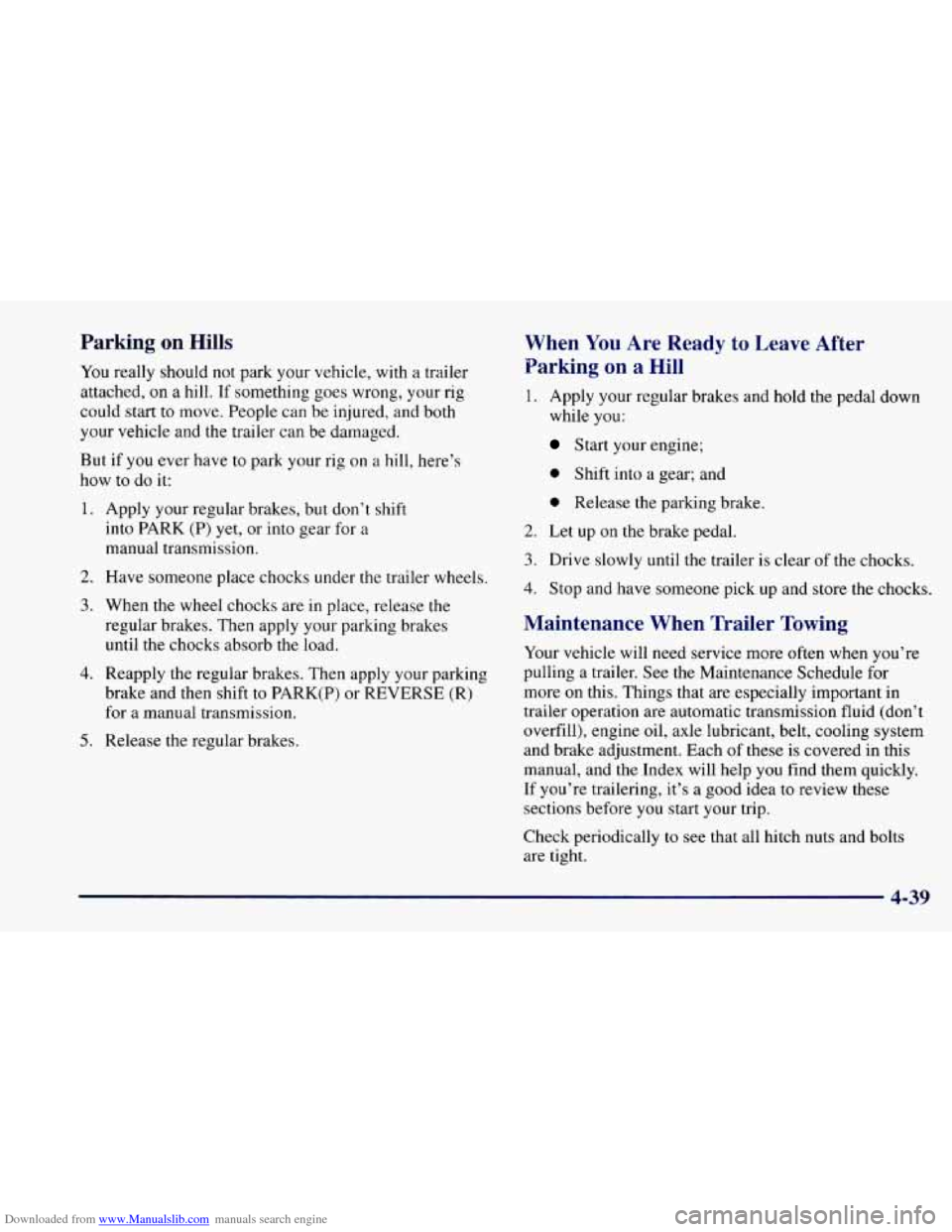
Downloaded from www.Manualslib.com manuals search engine Parking on Hills
You really should not park your vehicle, with a trailer
attached, on
a hill. If something goes wrong, your rig
could start
to move. People can be injured, and both
your vehicle and the trailer can be damaged.
But if you ever have to park your rig on a hill, here’s
how to do it:
1.
2.
3.
4.
5.
Apply your regular brakes, but don’t shift
into PARK (P)
yet, or into gear for a
manual transmission.
Have someone place chocks under the trailer wheels.
When the wheel chocks are
in place, release the
regular brakes. Then apply your parking brakes
until the chocks absorb the load.
Reapply the regular brakes. Then apply your parking
brake and then shift to PARK(P) or REVERSE (R)
for a manual transmission.
Release the regular brakes.
When You Are Ready to Leave After
Parking on
a Hill
1. Apply your regular brakes and hold the pedal down
while you:
Start your engine;
0 Shift into a gear; and
0 Release the parking brake.
2. Let up on the brake pedal.
3. Drive slowly until the trailer is clear of the chocks.
4. Stop and have someone pick up and store the chocks.
Maintenance When Trailer Towing
Your vehicle will need service more often when you’re
pulling
a trailer. See the Maintenance Schedule for
more on this. Things that are especially important
in
trailer operation are automatic transmission fluid (don’t
overfill), engine oil, axle lubricant, belt, cooling system
and brake adjustment. Each
of these is covered in this
manual, and the Index will help
you find them quickly.
If you’re trailering, it’s a good idea to review these
sections before you start your trip.
Check periodically
to see that all hitch nuts and bolts
are tight.
4-39
Page 247 of 404
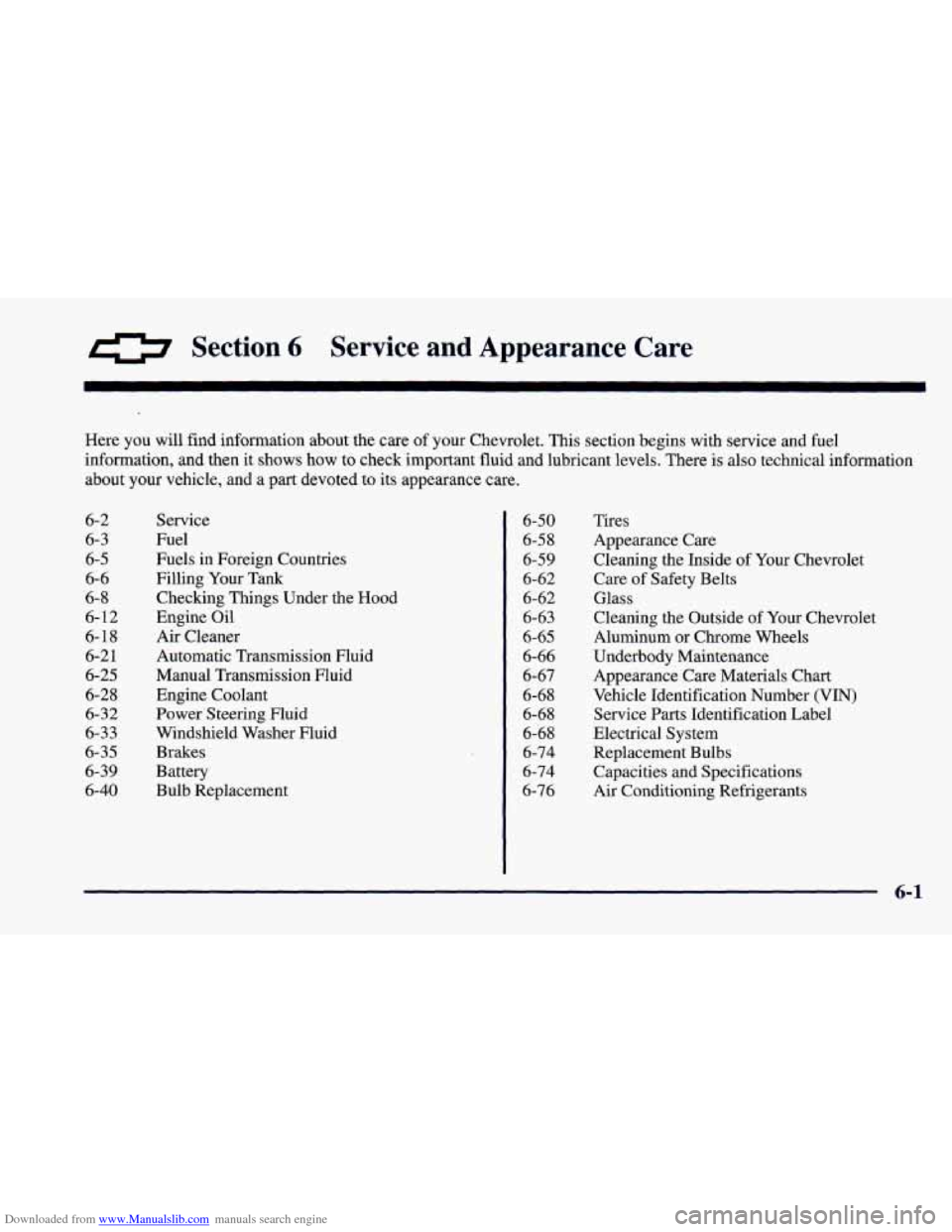
Downloaded from www.Manualslib.com manuals search engine 0 Section 6 Service and Appearance Care
Here you will find information about the care of your Chevrolet. This section begins with service and fuel
information, and then it shows how to check important fluid and lubricant levels. There is also technical information
about
your vehicle, and a part devoted to its appearance care.
6- 2
6-3'
6-5
6-6
6-8
6- 12
6-18
6-2
1
6-25 6-28
6-32
6-33
6-35
6-39
6-40 Service
Fuel
Fuels
in Foreign Countries
Filling Your Tank
Checking Things Under
the Hood
Engine Oil
Air Cleaner Automatic Transmission Fluid
Manual Transmission Fluid
Engine Coolant
Power Steering Fluid
Windshield Washer Fluid
Brakes
Battery
Bulb Replacement
6-50
6-58
6-59
6-62
6-62
6-63
6-65
6-66
6-67
6-68
6-68 6-68
6-74
6-74
6-76 Tires
Appearance Care
Cleaning the Inside of Your Chevrolet
Care of Safety Belts
Glass
Cleaning the Outside of Your Chevrolet
Aluminum or Chrome Wheels
Underbody Maintenance
Appearance Care Materials Chart
Vehicle Identification Number (VIN)
Service
Parts Identification Label
Electrical System
Replacement Bulbs
Capacities and Specifications
Air Conditioning Refrigerants
Page 251 of 404

Downloaded from www.Manualslib.com manuals search engine To provide cleaner air, all gasolines in the United States
are now required to contain additives that will help
prevent deposits from forming in your engine and fuel
system, allowing your emission control system to
function properly. Therefore,
you should not have
to add anything to the fuel. In addition, gasolines
containing oxygenates, such as ethers and ethanol, and
reformulated gasolines may be available in your area to
help clean the air. General Motors recommends that
you
use these gasolines if they comply with the
specifications described earlier.
NOTICE:
Your vehicle was not designed for fuel that
contains methanol. Don’t use
it. It can corrode
metal parts in your fuel system and also damage
plastic and rubber parts. That damage wouldn’t
be covered under your warranty.
Fuels in Foreign Countries
If you plan on driving in another country outside the
United States or Canada, the proper fuel may be hard to
find. Never use leaded gasoline or any other fuel not
recommended in the previous
text on fuel. Costly repairs
caused by use of improper fuel wouldn’t be covered by
your warranty.
To check on fuel availability, ask an auto club, or
contact a major oil company that does business in the
country where you’ll be driving.
You can also write us at the following address for
advice. Just tell
us where you’re going and give your
Vehicle Identification Number
(VIN).
General Motors International Product Center
1908 Colonel Sam Drive
Oshawa, Ontario
LlH 8P7
6-5
Page 254 of 404

Downloaded from www.Manualslib.com manuals search engine When you put the cap back on, turn it to the right
(clockwise) until you hear a clicking sound. Make sure
you fully install the cap. The diagnostic system can
determine
if the fuel cap has been left off or improperly
installed. This would allow fuel to evaporate into the
atmosphere. See “Malfunction Indicator Lamp” in
the Index.
NOTICE:
If you need a new cap, be sure to get the right
type. Your dealer can get one for you.
If you get
the wrong type,
it may not fit or have proper
venting,
and your fuel tank and emissions system
might be damaged.
Checking Things Under the Yood
- -
An electric fan under the hood can start up and
injure you even when the engine
is not running.
Keep hands, clothing and tools
away from any
underhood electric fan.
I /A CAUTION:
Things that burn can get on hot engine parts and
start a fire. These include liquids like gasoline,
oil, coolant, brake fluid, windshield washer and
other fluids, and plastic or rubber. You or others
could be burned. Be careful not
to drop or spill
things that will burn onto
a hot engine.